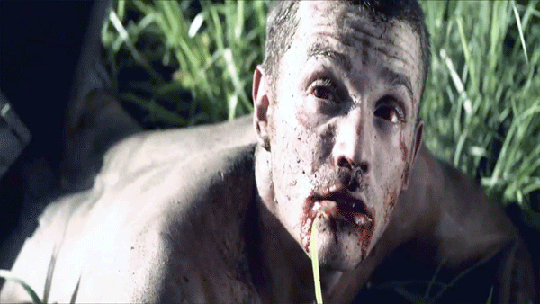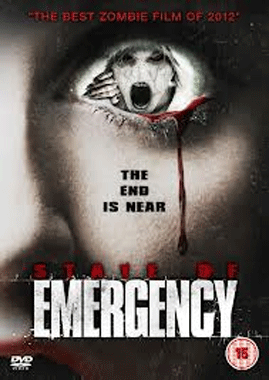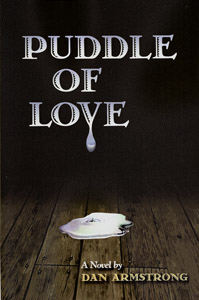
(Clay Bros. Motion Pictures; DVD release date: April 2013; 90 minutes)
So the other night I was browsing Netflix's instant view collection for a good, recent zombie movie with which to satiate my doomerish craving for mass societal mayhem and collapse, when I came upon a film called State of Emergency. My advice to you is that if in coming days you find yourself doing the same thing, don't make the same mistake. The film is egregiously clichéd, foolishly plotted and wildly unbelievable–in short, it's a reanimated turkey of a zombie movie.
The setting is a remote farming community cagily located in "Montgomery County" (there are actually several Montgomery counties in the United States, and we're given no clues as to which one it might be), where an explosion has occurred at an old chemical weapons plant. Our hero, a rugged country boy named Jim (Jay Hayden), is recently bereaved of his fiancée and now spends his time holed up in an abandoned barn with a Lee-Enfield bolt-action rifle that he found. The area seems totally deserted except for a red-eyed, drooling nasty that Jay dispatches at the beginning of the film, during what is admittedly a halfway decent action/suspense sequence.

But here's where the plot begins to break down, crippled by silly implausibilities and contradictions. A phone in the barn starts ringing, and when Jim picks up he talks with a nearby Samaritan named Scott (Scott Lilly). "Are you the person in the barn?" asks Scott breathlessly. When Jim answers yes, Scott goes on, "Thank God; I tried every number in the book. We heard gunshots. Are you okay?" Don't ask how Scott knew that this was the right number. The next bit of silliness comes when Scott signals his party's location to Jim by flicking the lights in their building. Just moments later, however, while giving Jim a tour of the place, Scott boasts that they don't have to worry about blazing their lights because there are no windows. Huh? But this next one's my favorite. When Scott first greets Jim, he prudently wears a face mask—which he never puts on again for the rest of the movie. How has this guy lasted? Must be pity on the zombies' part for creatures slower than they are.
The whole storyline is flawed. Perhaps in an effort to liven up an otherwise dull plot, writer and director Turner Clay resorts to a framing device that feels tacked on. In classic films like Citizen Kane and Pulp Fiction, the use of a nonlinear frame structure makes sense; it is central to the development and meaning of the tale. When the story bends back around to meet itself, it brings the emotional arc of the characters into sharp relief. But the frame used in this film is a gimmick with no point. And what passes for the rest of the plot involves the characters doing nothing but hunkering down in the abandoned building commandeered by Scott's group, and bloodily dispatching the zombies that proceed to penetrate its defenses. Oh, and there's also a subplot in which Jim braves the zombie-ridden landscape in search of medicine for—you'll never guess—a young diabetic woman in need of insulin (Tori White), who can't die because she's a romantic interest for Jim.
The most interesting performances are by the actors playing zombies; everyone else is paper-thin. Hayden's all-around good guy Jim is so gosh-darn nice he'll make you want to hurl worse than the monsters will. As for Scott Lilly's performance, the boneheaded ineptitude of his character is amusing at first but wears off quickly, and Lilly's baby-faced looks aren't enough of a relief from this annoyance. The female characterizations are even more grating. Actresses Tori White and Kathryn Todd Norman do little more than complain and drag down the rest of the group.
As I hinted earlier, I do have to concede that there are patches of genuine suspense. In one decent chase scene, Jim has to run from one end of an attic to the other and then drop down to the floor below, so that he can reach his rifle before the zombie hot on his heels reaches him. There are also a couple of chilling moments in which a character turns his back briefly and turns back around to see a trail of bloody footsteps that wasn't there before. But because the film doesn't care enough about the characters or the plot to give them any depth, such scenes are enjoyable only in isolation–we don't care what happens to anybody in the bigger picture.
Zombies, along with vampires and werewolves, are one of the flavors du jour of our current pop culture entertainments. Their ubiquity is often seen as mirroring the increasingly zombie-like state in which people in the industrial world are blindly lurching toward disaster. I, however, see a more literal, visceral horror reflected in movie zombies: the real-life monsters that slaughter unsuspecting crowds or trample one another to death in mindless dashes to retail sales. I'm terrified to imagine how many more such monsters might emerge once resource shortages hit and people in developed nations finally have something worth rioting over.

State of Emergency, it hardly bears saying by now, is not a film that does this theme any justice. For one that does, you could do no better than to see the still-horrifying, still-heart-pounding classic, from George A. Romero in 1968, that first defined the whole zombie movie genre: Night of the Living Dead.
Jesse Wallace's dilemma is that he knows too much. He knows all the deepest, darkest secrets of the little town of Briley, Oregon. But he can't tell a living soul. He knows the daughter of the town's most successful rancher is addicted to heroin and cocaine. He knows Briley''s highly respected parson is having an affair with a local prostitute. He knows that a sexually active young man is HIV positive, and he's seen two horrible murders. But he can't tell the town sheriff or inform the state police, because one of those murders was his own. Ever hear the story about the ghost in the whorehouse? This is it...

"Sharply drawn, memorable, and touching characters," writes Frank Kaminski, "and, with icy narrative precision, the main villain is utterly frightening and believable. Definitely a masterwork, and one that would reward many re-readings."
BUY NOW for $20.00 plus shipping directly from Mud City Press or from Amazon.com. As Kindle only $3.99!